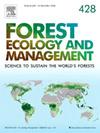Multi-decadal aspen dynamics show recruitment bottleneck across complex mountain community
IF 3.7
2区 农林科学
Q1 FORESTRY
引用次数: 0
Abstract
Changes in forest structure and shifts in tree species composition have occurred globally due to climate change and altered disturbance regimes. With climate trending toward warmer and drier conditions, these altered forest communities may reorganize in diverse and unpredictable ways. This is especially true in mountain environments where a range of vegetation types and abiotic conditions coexist. In this study, we used long-term permanent plot data from a site spanning broad environmental gradients to assess regeneration and mortality patterns in populations of aspen (Populus tremuloides). The study site, located on the San Francisco Peaks, Arizona, USA, is near the hot, dry edge of the species’ range and has experienced compounding pressure from extreme drought, chronic ungulate browsing, and wildfire in the past two decades. Over a 20-year study period, spanning one of the most prolonged drought periods in at least 1200 years, aspen overstory mortality averaged 42 % and was most common in smaller, younger trees and at lower elevations. Aspen regeneration density increased 13 % and was found in a greater proportion of study sites. However, we observed a noticeable lack of stems in the tallest regeneration size class (>200 cm) and the smaller tree size class (2.5–15 cm in diameter), potentially indicating a demographic bottleneck whereby few trees are recruiting into the overstory. Likewise, prolific aspen suckering occurred after a 2001 wildfire, although regeneration density eventually decreased to pre-fire levels, with <1 % of individuals reaching heights >200 cm. Aspen regeneration densities showed the greatest increases in cool, wet sites and beneath open forest canopies. Disturbances function as catalysts for aspen regeneration, but persistence of aspen stands depends on recruitment of stems into overstory size classes, a process that is limited, particularly on lower and more exposed sites.
十年间杨树的动态变化表明,复杂的高山群落中出现了招募瓶颈
由于气候变化和干扰机制的改变,全球森林结构和树种组成发生了变化。随着气候趋向于更温暖、更干燥,这些改变了的森林群落可能会以各种不可预测的方式重组。这在多种植被类型和非生物条件共存的山区环境中尤为明显。在这项研究中,我们使用了一个跨越广泛环境梯度的地点的长期永久小区数据,以评估杨树(山杨)种群的再生和死亡模式。研究地点位于美国亚利桑那州的圣弗朗西斯科峰,靠近该物种分布区炎热干燥的边缘地带,在过去二十年中经历了极端干旱、长期有蹄类动物啃食和野火等多重压力。在长达 20 年的研究期间,这里经历了至少 1200 年来最漫长的干旱期之一,杨树上层树木的平均死亡率为 42%,在较小、较年轻的树木和海拔较低的地方最为常见。杨树再生密度增加了 13%,在更多的研究地点发现了这一现象。但是,我们观察到,最高再生尺寸等级(>200 厘米)和较小树木尺寸等级(直径 2.5-15 厘米)中的茎干明显不足,这可能表明出现了人口瓶颈,即很少有树木进入上层林木。同样,在 2001 年的一场野火之后,也出现了大量的杨树吸吮现象,尽管再生密度最终下降到了火灾前的水平,只有 1% 的个体达到了 200 厘米的高度。在凉爽、潮湿的地方和开阔的林冠下,杨树的再生密度增加最多。干扰是杨树再生的催化剂,但杨树林分的持久性取决于上层林分大小等级的茎的吸收,而这一过程是有限的,尤其是在较低和较暴露的地点。
本文章由计算机程序翻译,如有差异,请以英文原文为准。
求助全文
约1分钟内获得全文
求助全文
来源期刊

Forest Ecology and Management
农林科学-林学
CiteScore
7.50
自引率
10.80%
发文量
665
审稿时长
39 days
期刊介绍:
Forest Ecology and Management publishes scientific articles linking forest ecology with forest management, focusing on the application of biological, ecological and social knowledge to the management and conservation of plantations and natural forests. The scope of the journal includes all forest ecosystems of the world.
A peer-review process ensures the quality and international interest of the manuscripts accepted for publication. The journal encourages communication between scientists in disparate fields who share a common interest in ecology and forest management, bridging the gap between research workers and forest managers.
We encourage submission of papers that will have the strongest interest and value to the Journal''s international readership. Some key features of papers with strong interest include:
1. Clear connections between the ecology and management of forests;
2. Novel ideas or approaches to important challenges in forest ecology and management;
3. Studies that address a population of interest beyond the scale of single research sites, Three key points in the design of forest experiments, Forest Ecology and Management 255 (2008) 2022-2023);
4. Review Articles on timely, important topics. Authors are welcome to contact one of the editors to discuss the suitability of a potential review manuscript.
The Journal encourages proposals for special issues examining important areas of forest ecology and management. Potential guest editors should contact any of the Editors to begin discussions about topics, potential papers, and other details.
 求助内容:
求助内容: 应助结果提醒方式:
应助结果提醒方式:


